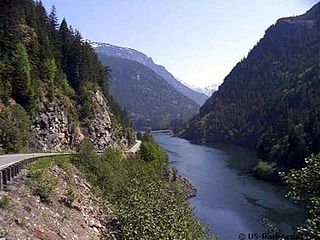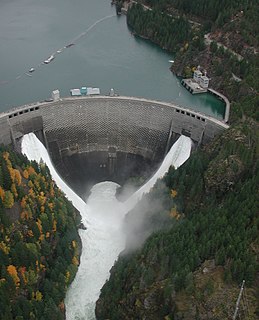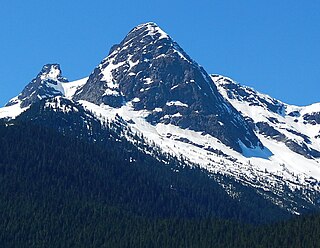| Thunder Creek [1] | |
|---|---|
Thunder Creek | |
| Country | US |
| Physical characteristics | |
| Main source | Near Park Creek Pass 5,590 ft (1,700 m) 48°35′29″N122°04′52″W / 48.59139°N 122.08111°W |
| River mouth | Diablo Lake 1,200 ft (370 m) 43°36′01″N122°14′05″W / 43.60028°N 122.23472°W Coordinates: 43°36′01″N122°14′05″W / 43.60028°N 122.23472°W |
| Length | 15 mi (24 km) |
| Basin features | |
| Tributaries |
|
Thunder Creek is a stream located entirely within North Cascades National Park and the Ross Lake National Recreation Area in the US state of Washington. [2] Thunder Creek runs in a northerly direction most of its route starting from just north of Park Creek Pass in the south district of North Cascades National Park and ending at Diablo Lake in Ross Lake National Recreation Area. Prior to the construction of the Diablo Dam, Thunder Creek emptied into the Skagit River. A popular hiking trail parallels Thunder Creek its entire length. Thunder Creek is well known for having a turquoise appearance from the suspended silt and rock flour caused by runoff from dozens of glaciers, including the largest glacier in the park, Boston Glacier, which feeds Skagit Creek, a tributary stream. [3]

North Cascades National Park is an American national park in the state of Washington. At more than 500,000 acres (200,000 ha), North Cascades National Park is the largest of the three National Park Service units that comprise the North Cascades National Park Complex. North Cascades National Park consists of a northern and southern section, bisected by the Skagit River that flows through Ross Lake National Recreation Area. Lake Chelan National Recreation Area lies on the southern border of the south unit of the park. In addition to the two national recreation areas, other protected lands including several national forests and wilderness areas, as well as Canadian provincial parks in British Columbia, nearly surround the park. North Cascades National Park features the rugged mountain peaks of the North Cascades Range, the most expansive glacial system in the contiguous United States, the headwaters of numerous waterways, and vast forests with the highest degree of flora biodiversity of any American national park.

Ross Lake National Recreation Area is a US National Recreation Area located in north central Washington just south of the Canada–US border. It is the most accessible part of the North Cascades National Park Service Complex which also includes North Cascades National Park and Lake Chelan National Recreation Area. Ross Lake NRA follows the Skagit River corridor from the Canada–US border to the western foothills of the Cascades. The NRA contains a portion of scenic Washington State Route 20, the North Cascades Highway, and includes three reservoirs: 12,000-acre (4,900 ha) Ross Lake, 910-acre (370 ha) Diablo Lake, and 210-acre (85 ha) Gorge Lake. These reservoirs make up the Skagit Hydroelectric Project operated by Seattle City Light. Nestled in the "American Alps" the Ross Lake NRA bisects the north and south units of North Cascades National Park. The Shape of the National Recreation area, was designed to prevent the proposed High ross dam from flooding the national park.

Diablo Lake is a reservoir in the North Cascade mountains of northern Washington state, United States. Created by Diablo Dam, the lake is located between Ross Lake and Gorge Lake on the Skagit River at an elevation of 1,201 feet (366 m) above sea level. Diablo Lake is part of the Skagit River Hydroelectric Project and managed by Seattle City Light. Diablo Lake Trail, designated a National Recreation Trail in 1981, runs for 3.80 miles (6.12 km) along the lake's northern shore.














